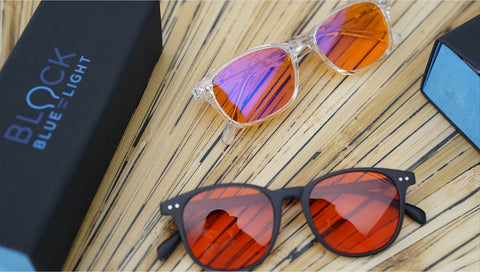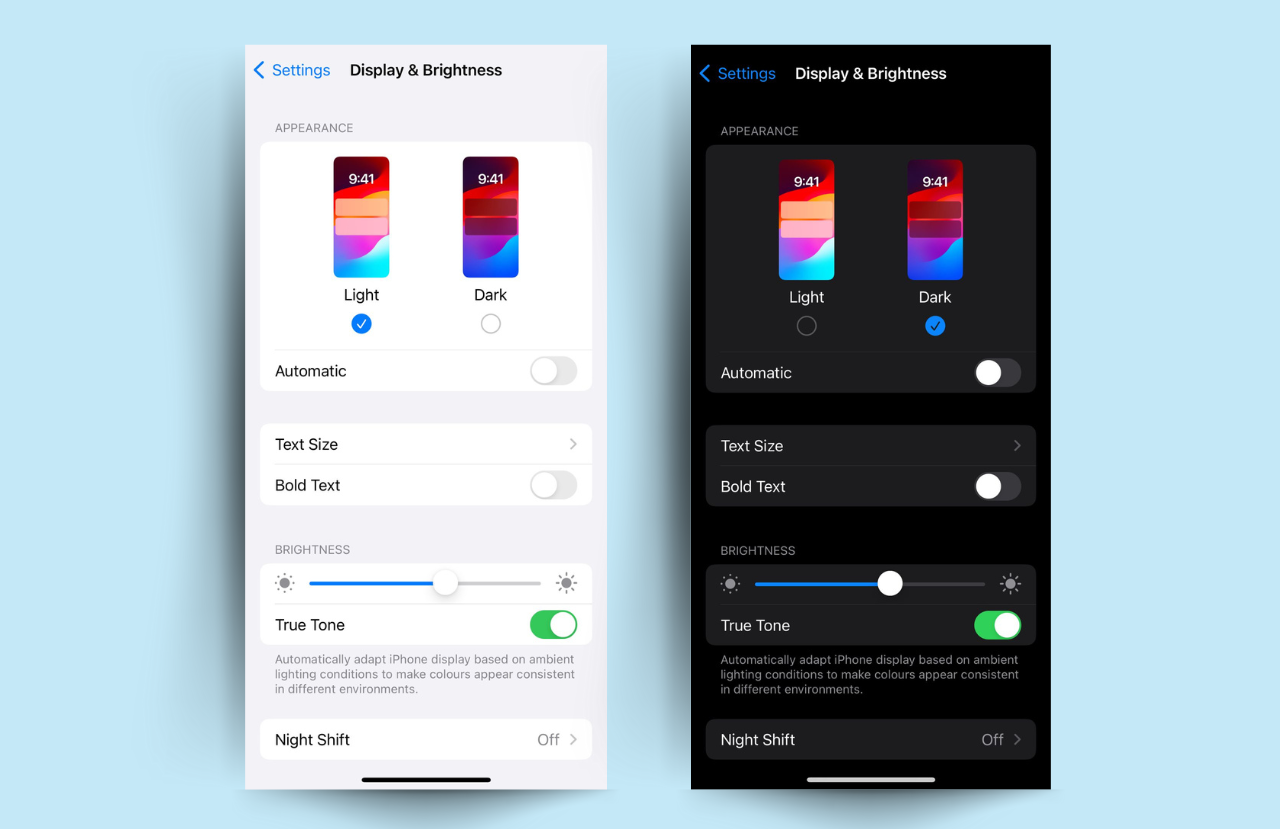Artificial light is radiated all around us from objects like lamps, bulbs, smartphones and computers. There has been a lot of research about artificial light and how it can impact our physical health, especially migraines. Hence, this this article will focus on describing what artificial light is, what a migraine is, and what is its prevalence. It will also focus on describing key research studies concerning how artificial light may induce migraines and what we can do to overcome them.
Let’s start off by answering the question: “Can excessive blue light exposure cause migraines?” The answer is, yes. This is because, we have specific neural pathways in our brain that became activated if we are sensitive to artificial light. Hence, this in return may cause an extreme headache, or a migraine attack. However, there are things that can be done to reduce this migraine, such as using blue light computer glasses during the day and blue light blocking glasses at night time.
What is artificial light?

Artificial light is a form of human-made light that we receive from electric devices. The most common type of artificial light is the blue light, which is part of the visible light spectrum. Blue light vibrates within the 380 to 500-nanometer range, hence, it has the shortest wavelength and the highest energy (1). Artificial blue light sources can include incandescent light, compressed fluorescent light (CFL) bulbs, LED bulbs, flat-screen LED televisions, computer monitors, smartphones and tablet screens. Disturbance of the body clock and sleep-wake cycle, triggered by exposure to unnatural light, can have a significant effect on health, efficiency, and wellbeing (1). In humans, light information is sent to the circadian pacemaker, found in the hypothalamic suprachiasmatic nucleus, through photosensitive retinal ganglion cells (2). Our brain then processes it as an image. However, sometimes this can cause problems if the light source is not pleasant. This article will focus on how artificial light, such as blue light, contributes to migraines.
What is a migraine?
Mayo Clinic (3) defines migraine as significant excruciating pain or a pulsing sensation, usually on one side of the head. It is complemented by nausea, vomiting, and extreme sensitivity to light and sound. Migraine attacks can be so severe, as sometimes they may stay for days and significantly reduces daily activities (3). There are four stages in which a migraine progresses: prodrome, aura, attack and post-drome (3).
- Prodrome: this phase starts two days before a migraine, where individuals see changes such as constipation, mood fluctuations, diet cravings, drowsing feeling, increased dehydration and neck stiffening.
- Aura: this phase can occur during a migraine, and includes adjustable symptoms of the nervous system. These symptoms can last 20 to 60 minutes, and they include seeing bright spots, losing vision, pin and needles sensation in arms, difficulty speaking and hearing noises.
- Attack: this is the main phase of migraine where people experience throbbing pain, sensitivity to light, nausea and vomiting. This can last from four to 72 hours, depending on the severity.
- Post-drome: this indicates the end of a migraine. However, people may feel drained, confused, and out of place for a day or two.
Prevalence of migraines
According to the Deloitte Access Economics Report (4), 4.9 million Australians suffer from migraines, and this increases in people 12 years to about 40 years. This report also stated that 71% of migraine sufferers are women, and 86% are of working age. The most concerning finding was that 7.6% of migraine subjects have chronic migraine, i.e. more than 15 migraine days per month. Overall, it has been anticipated that the occurrence of a headache disorder is about 50%. Half to three-quarters of the world's adults aged 18–65 had a headache in the last year, and 30 per cent or more experienced a migraine. WHO reported (5) that in the Global Burden of Disease Study, migraine on its own was found to be the sixth leading cause globally of years lost due to disability (YLD).
Artificial light and migraines
There are many causes of migraines such as hormonal changes in women, drinking too much alcohol, stress, changes in sleep, physical exertion, weather changes and medications such as oral contraceptives. However, the leading cause of migraines which is expressively evident in 2020, is sensory stimuli such as artificial light. When we look at the artificial light that is radiated from electronic devices, they do not emit their light in a steady stream; they pulsate light out at us, this is commonly known as flicker. Reportedly, this flickering effect from artificial light causes migraines. Researchers became interested in learning about the effects of artificial light from digital media in the late 1990s (6) when 685 children were suddenly hospitalized for neurological reactions to specific visual images. These neurological reactions included dizziness, headaches, and even seizures. It was conceived that if schools used more digital devices, there might be a potential for similar unfavourable effects to classroom visual images. Light-emitting photographic communication incorporates interactive whiteboards (IAWs), tablets, phones, laptops and computers. These light-emitting photographic communication devices are characterized as digital media. Two researchers Preston and Mowbray (7) showed that SMART blackboards which emitted artificial light increased student engagement. However, for a student who had light sensitivity problems, this caused adverse effects such as headaches and migraines (8). Ultimately, the emergence of digital media in schooling has slowly amplified access of the student to digital media that emit artificial light. This can, in return, cause disability for light-sensitive students, especially those with migraine problems.
Artificial light from smartphones and migraines
Numerous research, including screen time on computers, have examined the factors that dispose of individuals with migraines. Nevertheless, there is limited data on the use of smartphones or tablets, particularly among young adults. Therefore, researchers (9) conducted a cross-sectional study, including 4,927 French college students from the and analyzed self-reported data on screen time exposure and symptoms of headache and migraine. The findings of this study showed that screen time on smartphones was associated with headaches accompanied by nausea or vomiting, and sensitivity to light or sound was classified as migraine. The results from this study also showed that migraine led with visual, sensory or motor instabilities was categorized as a migraine with aura. Hence, we can conclude that smartphones that produce artificial light can cause headaches and migraines in adults.

Artificial Light characteristics that play a role in migraine
Many patients have stated that modern LED light is a cause for their migraine attacks and that a migraine attack can occur within just a few seconds of exposure (10). There are specific lighting characteristics and types of which can play a damaging role for people who suffer from a migraine:
Blue-green wavelengths of light
Studies show that blue-green light, particularly one with 455 nanometers, is predominantly distressing. Such wavelengths can disturb sleep cycle, contribute to eye strain and, also cause significant throbbing pain for people with migraine (11). Smartphones, computers and any device with artificial light have made these wavelengths more blatant.
The invisible flicker of fluorescent and LED lighting
Artificial lights such as LED light presents an undetectable pulsing that is unnoticeable to the human eye, but is still sensed by the brain. When people become severely sensitive to this pulsing, it is called "fluorescent and LED sickness", and people who suffer from migraines can be rigorously impacted. One research study (12) showed that invisible flicker of fluorescent and LED lights amplified the migraine frequency in working people.
Flashing and other high-contrast light
Artificial lights such as car headlights, flashing strobe lights or light reflecting off snow have also been a substantial cause for those who suffer from migraine attacks. Thus, social activities, such as attending concerts and movies, can be challenging for people with migraine.
Artificial light and migraines in Photophobia
Photophobia is a condition where the headache is exacerbated by artificial light, and this is associated with meningitis, concussion, subarachnoid hemorrhage and migraines (13). 80% of people who have migraines, suffer from Photophobia as well (13). Researchers studying this phenomenon (14) found that artificial blue light caused migraine-type Photophobia. Accordingly, artificial blue light is the most excruciating hue; it's also the most commonly emitted colour on computer and smartphone screens which can cause a migraine.
They also found that this exacerbation of migraine-type headache can be reduced by using glasses or contact lenses that block this artificial blue light.
However, how does this happen? Research (15) findings indicate that migraine photophobia begins in retinal cone pathways, fine-tuned in the thalamus, modified in relay thalamic neurons, and conserved by the cortex. Thus, this shows that artificial light, such as blue light can have a significant effect in the brain, which may make the migraine worst.
Migraines are usually aggravated due to light-sensitivity, as it is one of the most common symptoms of migraines. In a recent survey (16), 89% of people reported that they became tremendously sensitive to light during their migraine attack. These people also reported that photophobia and light sensitivity remained a significant concern during the recovery phase, i.e. post-drome phase.
Why light causes migraine attacks?
Neuroscience based research is trying to find answers to such questions. The most plausible evidence suggests that specific neural pathways from the eye to the brain are activated when a migraine attack occurs. This eventually leads to sudden awful light sensitivity and migraine symptoms (17). However, some other researchers believe that there are specific cells in the eye that are highly sensitive to wavelengths of artificial light (17). Most relevant recent research in this area has found that there are changes in the dopamine - which is a neurotransmitter in the brain responsible for movement, emotion, and pleasure – may be able to explain why migraine attack occurs due to light sensitivity. However, more research is required in this area in order to confirm this causal relationship.
Is there is a treatment for migraines that are caused due to artificial light?
The short answer is yes. Now medication might seem like the most suitable and easiest treatment. However, it usually comes with unwanted side effects can most certainly be harmful to long-term health and well-being. Hence, we will provide some of the proven and sustainable strategies which can help minimise light triggers and prevent migraine attacks (18).
Migraine Mitigation Strategies
Wear Blue Light Blocking Glasses at night


Migraines have been linked to a lack of sleep and stress. So using techniques to lower stress and improve sleep quality are going to help eliminate migraines. Evening exposure to blue and green light can send an erroneous ‘rise and shine’ message to the brain, and interrupt the sleep-wake cycle. Blue Light Glasses are useful at night time when exposed to artificial light sources. Ensure you use a pair of verified and tested glasses that block 100% of blue and green light. These glasses provide the most optimal blue (and green) light protection available to maximize sleep quality.
Use Blue Light Computer Glasses during the day
Using computer glasses that specifically designed to permit the good light responsible for alertness, brain activity, and optimal health whilst filtering the harmful artificial blue light that leads to digital eye strain, migraines, and macular degeneration, are a must have in your migraine prevention tool box.
The exact wavelength of blue light emitted by screens, devices, and lighting that has been shown to trigger migraines is 455nm. When selecting a pair of computer glasses to help with migraine prevention make sure they are verified to filter blue light by 50% at the 455nm range.
Our ScreenTime Computer Glasses filter the migraine trigering blue light (455nm) by 50%. Most computer glasses available only filter blue light up 430nm and don’t filter any light at 455nm, so please do your research before making a purchase if want a set of computer glasses that are effective at preventing migraines.
Install Flicker Free Lighting
Conventional LED and fluorescent lighting all produce very high amounts of flicker. The way these lights flicker is they have quick fluctuations in brightness which is essentially the light changing between on and off. The reason they are switching themselves on and off at rapid speeds is due to the alternating current power supply, and also to make them energy efficient.
The pulsing flicker that these lights produce is mostly not visible to the human eye due to is rapid speed, but our brains can still pick up and sense this pulsing light. As mentioned earlier the flicker found in all modern lighting is a major cause of migraines, headaches and eye strain.
While using Anti Blue light Glasses and Computer Glasses can help with the management of blue light and green light from LED and fluorescent lighting, they cannot eliminate or mitigate the effects of flicker. A flicker free light bulb is the only solution to avoid this migraine causing type of light.
Fortunately we have created a series of flicker free lighting solutions that has completely eliminated any flicker and blue light. Making it the healthiest type of lighting you can be using to avoid migraines, headaches, eye strain, and sleep disruption.
Take a break in complete darkness
Relaxing in a dark room remains one of the most common self-care practices in people with migraine. This gives rest to eyes and can even reduce the intensity of the migraine attack. Normally during the day it can be difficult to create complete darkness is a room, light will get through gaps in the curtains and through windows. Using our Delta Sleep Mask fixes this problem, it completely eliminates 100% light entering your eyes, this creates the "pure darkness" for your brain. This strategy of a pure darkness break has been proven to significantly reduce the intensity and length of migraine attacks.
Final Thoughts
In conclusion, we can see that artificial light is associated with migraines as it can exacerbate the intensity, but also cause withdrawal from social activities. This can be concerning for people who have office related jobs and use computers daily. However, using natural strategies and proven products to reduce or even completely eliminate migraines as your best way to live a migraine free lifestyle.
References
- https://www.bmh.manchester.ac.uk/research/impact/artificial-lights/
- Berson M, Dunn A, Takao M. Phototransduction by retinal ganglion cells that set the circadian clock. Science. 2002; 295(5557):1070-3.
- https://www.mayoclinic.org/diseases-conditions/migraine-headache/symptoms-causes/syc-20360201
- https://www2.deloitte.com/au/en/pages/economics/articles/migraine-australia-whitepaper.html#
- https://www.who.int/news-room/fact-sheets/detail/headache-disorders
- Janene S, Judith M, Susan L. Screens and teens with migraines: visually sensitive learners in contemporary digital classrooms. Disability & Society. (2017); 32:8, 1275-1279.
- Preston, Chris, Mowbray. Use of SMART Boards for Teaching, Learning and Assessment in Kindergarten Science. Teaching Science . 2008; 54 (2): 50–53.
- Wilkins, Arnold, Emmett, J and Harding G. Characterizing the Patterned Images That Precipitate Seizures and Optimizing Guidelines to Prevent Them. Epilepsia. 2005; 46 (8): 1212–1218.
- Montagni, I. et al. Screen time exposure and reporting of headaches in young adults: a cross-sectional study. Cephalalgia.
- Kelman L. The triggers or precipitants of the acute migraine attack. Cephalalgia. 2007 ;27(5):394-402.
- M. Tatsumoto, T. Eda, T. Ishikawa, M. Ayama, K. Hirata. Light of Intrinsically Photosensitive Retinal Ganglion Cell (ipRGC) Causing Migraine Headache Exacerbation. IHC symposium OR3. 2013.
- Wilkins A, Veitch J, Lehman B. LED lighting flicker and potential health concerns: IEEE standard PAR1789 update. Energy Conversion Congress and Exposition. 2010;171-178.
- Kawasaki A, Purvin VA . Photophobia as the presenting visual symptom of chiasmal compression. J Neuroophthalmol. 2002; 22 : 3 – 8
- Zaidi FH, Hull JT, Peirson SN, Wulff K, Aeschbach D, Gooley JJ, et al. . Short-wavelength light sensitivity of circadian, pupillary, and visual awareness in humans lacking an outer retina . Curr Biol. 2007; 17 : 2122 – 8 .
- Noseda, R., Bernstein, C. A., Nir, R. R., Lee, A. J., Fulton, A. B., Bertisch, S. M., Hovaguimian, A., Cestari, D. M., Saavedra-Walker, R., Borsook, D., Doran, B. L., Buettner, C., & Burstein, R. Migraine photophobia originating in cone-driven retinal pathways. Brain : a journal of neurology. 2016; 139(Pt 7), 1971–1986.
- https://migraine.com/graphics/in-america-studies/migraine-in-america-2016/2/
- Noseda R, Kainz V, Jakubowski M, Gooley JJ, Saper CB, Digre K, Burstein R. A neural mechanism for exacerbation of headache by light. Nature Neuroscience. 2010;13(2):239-45.
- Malone CD, Bhowmick A, Wachholtz AB. Migraine: treatments, comorbidities, and quality of life, in the USA. Journal of Pain Research. 2015;8:537-547.
- Fine PG, Digre KB. A controlled trial of regional sympatholysis in the treatment of photo-oculodynia syndrome. J Neuroophthalmol. 1995;15:90–94.
- Diener HC, Dodick DW, Aurora SK, Turkell CC, DeGryse RE, Lipton RB, Silberstein SD, Brin MF. OnabotulinumtoxinA for treatment of chronic migraine: results from the double-blind, randomized, placebo-controlled phase of the PREEMPT 2 trial. Cephalalgia. 2010;30:804–814.










